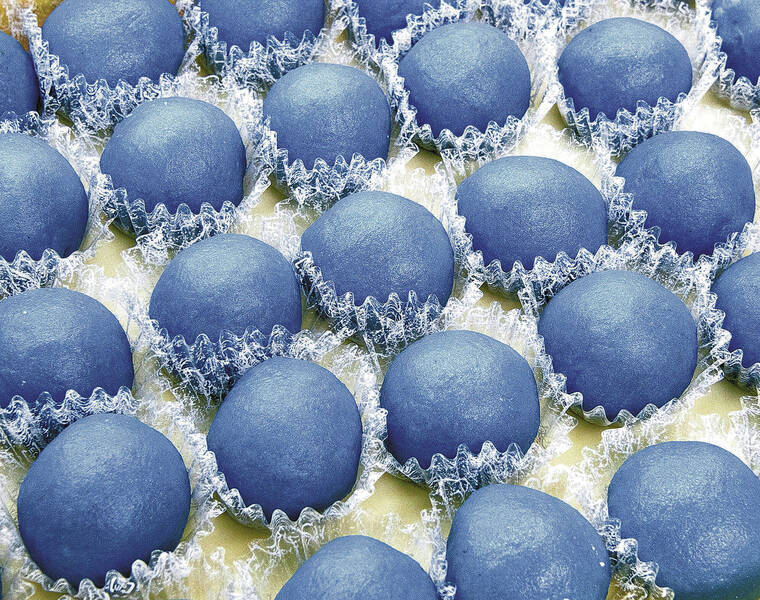Biwako Blue food makes a splash

KOKA MOCHI KOBO VIA JAPAN NEWS-YOMIURI
Powdered butterfly pea flowers turns mochi bright blue.
OTSU, Japan >> Taiyaki fish-shaped pastry, somen noodles, mochi and more are coming down with a case of the blues around Lake Biwa in Shiga prefecture.
Food products made with natural blue coloring are being produced in the prefecture one after another and are proving more popular than expected, especially among young people keen for their next social media-worthy moment.
Moves are afoot to trademark the name “Biwako Blue” (Lake Biwa blue) and make bright blue food a nationwide craze.
At a food truck set up in front of the Shiga government office in November, blue mochi was selling like hotcakes. Customers were mainly young people, and many immediately snapped pictures and posted them on social media. The 200 pieces prepared for the day were sold out in about an hour.
“Our blue mochi sells out quickly, both at the truck and at food events,” said Sadao Kawai, the representative of Koka Mochi Kobo, a rice processing and sales company in Koka, Shiga prefecture. “I was determined to break through the sales slump caused by the COVID-19 pandemic, but this has exceeded my expectations.”
The blue rice cakes are among about 40 products created under the Biwako Blue Project, which launched last March.
Don't miss out on what's happening!
Stay in touch with breaking news, as it happens, conveniently in your email inbox. It's FREE!
Nihon Advanced Agri Co., a food and beverage company in Nagahama, developed a natural blue coloring agent and has called for the development of more blue products. About 30 local companies and the Association of Bio Business Creation have joined on.
The raw material for the coloring is the butterfly pea, a legume that grows wild in Southeast Asia. The pea’s blue-violet petals are rich in anthocyanins, giving the plant its vivid blue color, and are used locally for dyes and herbal teas.
Nihon Advanced Agri learned about the butterfly pea when it expanded its business into Laos in 2014. An initial hurdle: The pea turned gray when processed for food production. But the company succeeded after three years in developing a vivid blue colorant in powder form using a special sterilization technology.
In September 2019 the Health, Labor and Welfare Ministry approved the use of the coloring as an additive in food products.
The first commercialized product — blue chocolate — was a hit, with about 30,000 boxes sold. The company then called on other food producers to use the coloring as a way to boost Shiga’s sluggish economy, hit hard by the COVID-19 crisis.
Nihon Advanced Agri aims to make the moniker Biwako Blue as common as matcha green tea.
Related products can be seen on the project’s website, biwakoblue.org.



